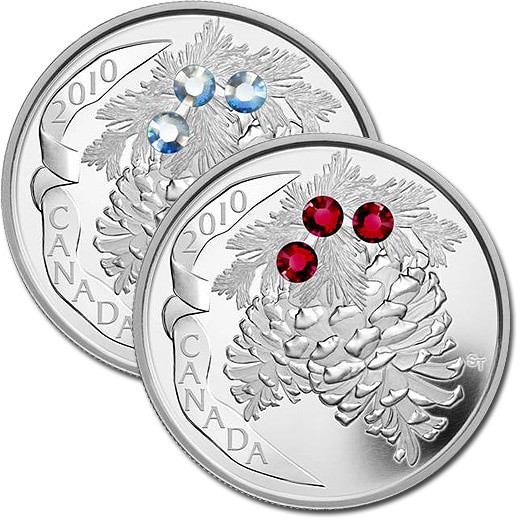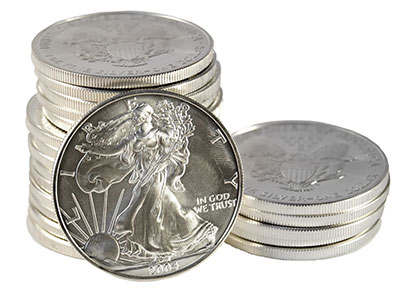BLOG | MEDIA | FAQ | LOCATIONS | CONTACT US
Sell Your Canadian Silver Coins
Silver Coins
Many people find themselves with gold jewellery that they decide to sell. This might be because pieces are broken or damaged, they are no longer wanted, or the owner would prefer to have their value in cash. But while selling gold is common, some may not consider the value their silver possessions represent. Silver coins, in particular, might be more valuable than you think.
Whether you are looking to sell your silver coins, or would simply like to learn more about them, keep reading.

How Do You Identify Silver Coins?
Before you can sell your coins, you need to first identify which, if any, are actually silver. Coins have varied in their silver content over the years. For example, Canadian silver dimes were composed of 92.5% silver from 1858 through 1919, but that dropped to 80% in 1920 and 50% in 1967. Depending on the year and country of origin, your silver coins could have a significantly different composition.
You will probably hear of several different tests to determine if your coins are real. Some, like the bleach test, are destructive to the coin and obviously are not ones that you will want to employ. Some of the easiest tests for identifying silver include the ping test, the magnet test, and simply looking at the coin.
The ping test involves simply dropping the coin on a table or tapping it with another coin and listening for the distinct ping sound made by real silver. On other coins, you can simply view the edge to see if it is visibly silver or copper. A copper stripe would indicate that the coin is clad or made up of multiple layers of metal.
Perhaps the easiest way to determine if your coins are silver is to use a magnet. Silver is not magnetic to any noticeable degree, so having your coin stick strongly to a magnet is a sure indication that it is not silver.
Once you have identified your silver coins, you can begin to assess their value.
What Silver Coins Are Worth Money?
Several factors determine what your silver coins are worth. Even older coins, which might be assumed to be valuable, are fairly often quite common and worth only the value of their silver content. Still, even common coins from the 20th century may be much more valuable than their face value.
Canadian silver nickels from before 1922 were made from coin silver or sterling silver. The high silver content of these coins resulted in many of them being melted over the years, making them quite rare today.
Another rare and valuable coin is the 1921 50-cent piece, of which only about 50 to 100 remain in circulation because the bulk of them were melted down to create later versions of the 50-cent piece. They are rare enough that one was auctioned off for $218,500 in 2010.
While there are valuable coins that turn up from time to time, for the average person, the value of their coins is related primarily to the silver content.

Level 1
Lorem ipsum dolor sit amet, consectetur adipiscing elit.
- Item 1
- Item 2
- Item 3
$9 per month
Level 1
Lorem ipsum dolor sit amet, consectetur adipiscing elit.
- Item 1
- Item 2
- Item 3
$9 per month
Level 1
Lorem ipsum dolor sit amet, consectetur adipiscing elit.
- Item 1
- Item 2
- Item 3
$9 per month
How To Figure Out Which Silver Coins Are of Higher Than “Scrap” Silver Value
Once again, this comes down to the amount of silver in the coin. In some instances, the scrap value of the silver in the coin will be higher than the face value of the coin as currency. In other cases, the market value of the coin might be higher than the scrap value. For example, certified coins tend to be trusted and valued, while also being easier to exchange for money.
How to Sort “Junk” Silver Coins at Home
Despite the name, “junk” silver coins aren’t coins devoid of value. The term “junk silver coin” refers to coins that are in fair condition but have additional value as a collectible. The value of the coin is based on the bullion value of the silver that it contains. So-called junk silver coins are in grades just below the threshold for collectible coins.
Sorting coins can be done at home. The amount of time and effort you wish to spend will help dictate the method used. Some will simply sort manually, reviewing the coins individually. This will require learning about grading and identifying coins. There are also automated sorters available, but they don’t come cheap.


Silver Purities By Year
In Canada, Sterling silver (.925) coins were issued from 1870 to 1919 for coins from dimes to half dollars. From 1920 through 1967, they used continental silver (.800) for coins from dimes to dollars. By 1967, they had put an end to .800 silver coins, reducing the fineness to .500 in 1967 and 1968.
The number associated with the type of silver is an indicator of its level of purity. Continental silver, for example, is .800, indicating that the coin is 80% silver and 20% alloy, while sterling silver (.925) is 92.5% silver and 7.5% copper or other metals.
Should You Polish Silver Coins?
It may seem counter-intuitive, but you should never try to remove the natural oxidation from coins. The tarnish on silver coins is known as “toning,” and the coin will be worth more so long as the toning remains intact. Products such as dips, polish, and chemical solutions should never be used to clean your coins.
Metal cleaners and other cleaning solutions use acids and/or abrasives to clean the metal, inflicting damage to the coin by removing some of the natural finish, or scratching the surface. Polishes result in an unnatural shine and may also inflict other damage. If your coins look like they need to be cleaned, that could actually indicate value.
Going one step further, some will tell you to avoid handling your coins altogether, except by holding them along the edges and exercising extreme care.
Do Coins Lose Value When Cleaned?
As mentioned above, attempting to clean your coins will likely result in some damage. Depending on the severity of the damage, you may find that the value of the coin is diminished by as much as 50% to 80%.
Cleaning the coin can cause permanent damage. There are coins dating back to the 19th century that still bear the mark of cleaning that was done in the 1800s.
Cleaning Silver Coins
For the average person, it is instinctive to want to clean older coins, to make them look more attractive and shine like new. While this is understandable, it is in your best interest to resist such impulses.
In truth, not all cleaning is automatically harmful, but many of the methods of cleaning available to the average person will cause damage. Just as you would hopefully not attempt to restore a valuable painting on your own, you should leave any attempts at cleaning to an experienced professional. You don’t want to risk losing half or more of the coin’s value simply to make it shinier.
Wrapping Coins in Aluminum Foil
It was once commonly advised to wrap coins in aluminum foil, but is that actually a good practice? Why was it done?
The original idea was that it could protect the coins. Collectors at one time would wrap their coins in aluminum foil before placing them in a paper roll. The idea was to prevent the coins from being toned by the paper. Unfortunately, this can also cause corrosion on the coins, making this method unsuitable for storing your coins.
Do Banks Accept Silver Coins?
While silver coins may be legal tender, some may be designated as collectibles and considered non-circulating legal tender. Banks and businesses may accept these coins at face value, but they are also not obliged to do so.
All banks will have the means to convert collectible coins to cash, but bank employees are not always aware of this. In such instances, the branch manager would be able to call the Mint and they will be walked through the conversion process.
In many cases, however, the bank is not an ideal choice for selling your silver coins as they will typically offer you the face value of the coin. This means, for example, that they will offer you 10 cents for a dime, without any regard for the silver content.
Your best bet when selling your silver coins is to contact a local coin dealer or a professional with experience buying coins and precious metals.
When you want to sell your silver coins, you want to be sure that you get top value. This means not only ensuring that you keep them in the best possible condition, but also bringing them to a trustworthy, experienced buyer such as Canada Gold, where we do everything we can to make the process easy and enjoyable for you.

Contact Us Today
For more information about caring for or selling your silver coins, contact us today. We’ll be happy to help.
Customer Success
What people say
“sources whereas high standards in web readiness. Energistically scale future-proof core competencies vis-a-vis impactful experiences. Dramatically synthesize integrated schemas with.”
 Luke SmithCEO & Founder odx
Luke SmithCEO & Founder odx“sources whereas high standards in web readiness. Energistically scale future-proof core competencies vis-a-vis impactful experiences. Dramatically synthesize integrated schemas with.”
 Irene J. HolmesPublications specialist
Irene J. HolmesPublications specialist
